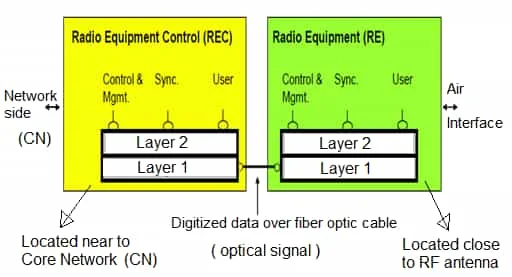What is RRH in 5G | Remote Radio Head in Telecom
Remote radio head (RRH) is a critical component in both 4G LTE and 5G telecom systems. It separates Radio Frequency (RF) processing from baseband processing into different modules. This reduces signal loss, improves coverage, capacity and overall network performance. RRH is part of overall base station which is responsible for RF processing, baseband processing and conversion of digital baseband to RF and vice versa for transmission and reception. RRH in 5G plays a crucial role in supporting the deployment of small cells, Massive MIMO (Multiple Input Multiple Output), and beamforming technologies.
RRH consists of Radio Equipment Control (REC) and Radio Equipment (RE) elements. In RRH, both BBU (i.e. REC) and RF front end (i.e. RE) are connected through high speed fiber optic cables using the common public radio interface (CPRI) protocol in 4G LTE. eCPRI (Enhanced CPRI) has been introduced in 5G NR system. REC module consists of baseband processing chain viz. scrambling, channel coding and modulation. RE module consists of ADC/DAC, PA, LNA and RF/IF filters. The interface between REC and RE elements is optical in nature. This optical signal carries Control/management, Sync and IQ signals. RRH is used to extend the coverage of a base station sub-systems in the remote rural areas.
REC is also known as Baseband Unit (BBU) which is located at central processing site. It is connected with RE on one side and core network on the other side. RF is also known as radio front end which interfaces with REC on one side and antenna on the other side. REC and RE functionalities vary in different cellular standards such as UTRA FDD, WiMAX, E-UTRA and GSM. The figure-1 depicts Base Station with RRH (Remote Radio Head). As shown, RF cabling is replaced with fiber optic cables in Base stations using RRH. Moreover RF and Baseband functionalities are separated in RE and REC modules respectively. This reduces RF signal loss due to RF cables and also bring RF units closer to the antennas as shown.

REC (BBU) performs functions such as handling digital data which include user data, control and management information and signaling. It consists of Channel coding/decoding, interleaver/deinterleaver, spreading/despreading, scrambling/descrambling modules, MIMO processing etc. in WiMAX and E-UTRA. Common Public Radio Interface (CPRI) and eCPRI specifications for RRH can be downloaded from CPRI.info website >>.

RE transmit chain consists of DAC (Digital to Analog Converter), RF upconverter using mixer and LO and PA (Power Amplifier). RE receive chain consists of LNA (Low Noise Amplifier), RF downconverter using mixer and LO and ADC (Analog to Digital Converter). The RF output of transmit chain is connected to RF antenna via RF duplexer or switch. Similarly RF antenna output is given to RF LNA via RF duplexer or switch.
RRH Interfaces:
Following three different information flows are multiplexed over digital interface. Both REC and RE houses layer-1 and layer-2 functionalities.
• Control and Management : Used for call processing and for operation and maintenance signals.
• Sync : Used for synchronization purpose, will carry timing information.
• IQ : The data which will be transported between radio base station system to the mobile station and vice versa.
Layer-1 supports electrical interface (i.e. RF processing as in traditional base stations), optical interface and TDM of different data types and low level signaling. Layer-2 supports MAC (Media Access Control), flow control and data protection of control/management information flow.
Remote Radio Head benefits
Following are benefits or advantages of Remote Radio Head (RRH) in cellular communication system.
➨By locating radio head closer to the antenna, signal loss due to RF coaxial cables can be eliminated.
➨Multiple RRHs can easily be interfaced with single BBU using fiber optic cables. This increases network capacity.
➨Multiple directional antennas serve users simultaneously which increases coverage.
➨By placing radio head closer to the antenna, less transmit power is required. This reduces energy consumption and operational costs.
➨RRH enables centralized baseband processing which allows efficient resource allocation and interference management.
This leads to improved network performance and reduced co-channel interference.
➨RRH technology enables easier upgrades and modifiations to the baseband unit. This enables quick product to the market
when different standard based technologies are available in future such as 5G and beyond.
Remote Radio Head Applications
RRH technology can be applied to various wireless communication systems particularly in cellular networks. The key applications include 5G NR networks, LTE networks, Distributed Antenna Systems (DASs), cellular network densification, fixed wireless access, Internet of Things (IoT), Railway and Transportation systems, Public safety networks, rural broadband, temporary events such as sports, concerts, fairs etc.
Conclusion In summary, Remote Radio Heads i.e. RRH in 5G telecom offer key advantages such as enhanced network flexibility, centralized baseband processing, and support for advanced technologies like Massive MIMO and beamforming. By decentralizing radio components and enabling efficient deployment of small cells, RRH contributes to improved network capacity, low-latency services, and optimal resource utilization in the rapidly evolving landscape of 5G communication.
